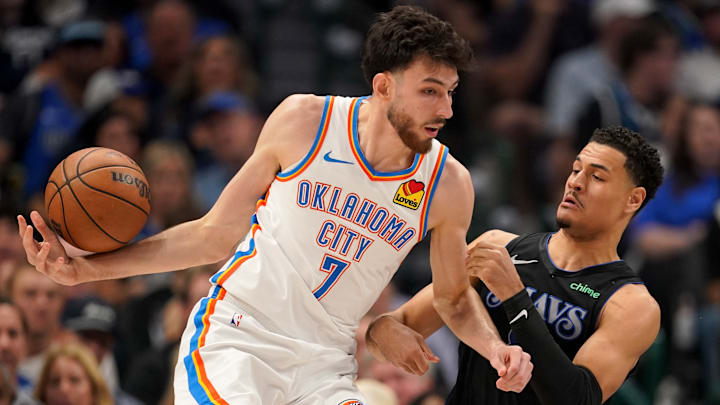Following an injury-induced, redshirted first year in the association, Chet Holmgren broke onto the scene during his debut 2023-24 campaign and, in turn, established himself as one of the top players on the history-shattering, top-seeded OKC Thunder.
Through 82 games played, the center posted incredible averages of 16.5 points, 7.9 rebounds, and 2.3 blocks on 53.0 percent shooting from the floor while boasting a sensation defensive rating of 108.
From his inside-out scoring intangibles to his elite shot-swatting abilities, the 22-year-old projects as one of the game's next great frontcourt talents and, had it not been for the astonishing play of Spurs wunderkind, Victor Wembanyama, we almost certainly would be referring to Holmgren as the reigning Rookie of the Year coming into his sophomore season.
However, despite his inarguably electric productivity, it's far from accurate to suggest that the Thunder youngster is already a finished product.
Within Holmgren's highly versatile game are a few areas that could use for some refinement. Today, we pinpoint three of the most prominent lacking aspects within his repertoire that must be improved upon before he can take his expected leap toward stardom.
Essential areas Thunder stud Chet Holmgren must improve upon
3. Distribution skills
It's easy to look at Chet Holmgren and label him as a tremendous offensive weapon. However, this is largely predicated on his ability to score from virtually anywhere on the court.
Though one's potential to buy a bucket is certainly a major draw in the modern-day game, a close second in the pecking order is a player's capability to create opportunities for those around them.
This is an area where Holmgren struggles mightily in.
In 29.4 minutes a game last season, Chet dished out an average of 2.4 assists and sported an assist percentage of just 11.6.
Now, this is not to say that the big man is incapable of finding his running mates for clean looks -- far from it as he's flashed some serious razzle-dazzle in the dime-dropping department that would give the likes of Steve Nash a double-take.
Chet went behind-the-back 🔥 pic.twitter.com/pBu4KYq68c
— NBA on ESPN (@ESPNNBA) November 7, 2023
However, this aspect of his game needs to become more of a common practice rather than a once-in-a-while highlight.
As noted earlier, rostering a 7-footer capable of putting the ball on the floor, jamming home lobs at the rim, and buying a bucket from long-range is certainly a luxury for any championship-hopeful squad.
However, having a talent like this also creating opportunities for others has proven to be absolute gold.
Just ask the Denver Nuggets.
2. Offensive rebounding
Already we've mentioned just how tall Holmgren is. To put this talking point even more into perspective, he is one of just 12 players heading into the upcoming campaign who measures in at above 7 feet tall.
Why is it, then, that despite this clear height advantage over the vast majority of players in the league he's only pulling down 1.6 offensive rebounds per game?
Sure, many will combat this factoid by arguing that Holmgren's game is more finesse and perimeter-heavy rather than ground-and-pound, battling in the paint-oriented and that his lacking 208-pound frame can't handle being down in the interior searching for second-chance opportunities.
While it may be the truth, it's not really all that great of an excuse, especially when considering the fact that a major reason why the Thunder were ultimately eliminated in round two of last year's postseason was their inability to secure second-chance points (outrebounded on the offensive glass 73 to 57 against the Dallas Mavericks while being outscored on second-chance opportunities 97 to 68).
Hit the weight room. Up the protein intake. Moving forward, Holmgren must look to do whatever needs to be done to take full advantage of his enviable size and improve in the offensive rebounding department.
No one should be expecting to see Clint Capela-esque numbers from him in this area of the game -- that would be wildly unreasonable.
Still, improving upon his 1.6 offensive boards per game should be a goal for him in 2024-25 and, frankly, it's not all that unreasonable of an ask.
1. Low-post work
Even after just one season of action, Holmgren has already thrust himself into the conversation of being one of the most difficult offensive matchups in the association.
With his 7-foot-1 frame and 7-foot-6 wingspan, coupled with his 37.0 percent three-point shooting clip on 4.3 attempts per game, guarding the former second-overall selection is an unquestionably tough task for any defender to take on.
That said, his scoring prowess and expertise largely revolve around his ability to space the floor and create off the dribble.
Put him in a post-up situation, however, and things become a bit more challenging.
Sure, against smaller defenders the big man has managed to fair well. However, when going up against talents his own size and bigger (the entire series between the Thunder and Mavericks, for example) it's quite clear that he has struggled to make anything happen with his lacking strength, back-down footwork, and ball fakes.
Adding to his low-post repertoire will only make him that much more lethal on the offensive end of the floor.
